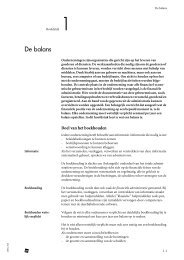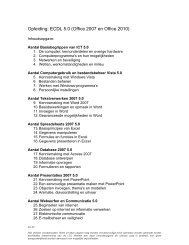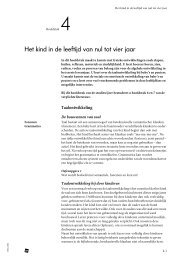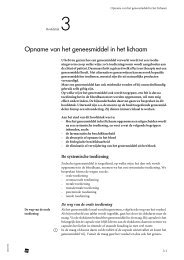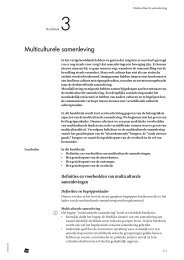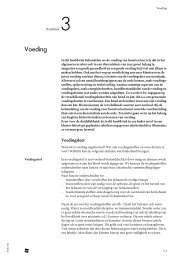Bekijk een hoofdstuk
Bekijk een hoofdstuk
Bekijk een hoofdstuk
Create successful ePaper yourself
Turn your PDF publications into a flip-book with our unique Google optimized e-Paper software.
Introductions<br />
Het Engels doet dat ook. All<strong>een</strong> gebruikt het Engels in veel gevallen <strong>een</strong><br />
hulpwerkwoord, namelijk to do. Als er <strong>een</strong> hulpwerkwoord wordt gebruikt,<br />
dan verliest de derde persoon enkelvoud (he/she/it)de -s achter de stam:<br />
to smoke He smokes Does he smoke<br />
to run She runs Does she run<br />
Hulpwerkwoorden<br />
Als er al <strong>een</strong> hulpwerkwoord in de zin staat, zoals may, can, have of het<br />
werkwoord to be dan hoeft to do niet gebruikt te worden:<br />
I can walk<br />
Can I walk<br />
I have eaten<br />
Have I eaten<br />
She is lonely<br />
Is she lonely<br />
Key exercise 10<br />
Maak de volgende zinnen vragend:<br />
1. They are in Europe again.<br />
2. The hotel accepts Visa and Mastercard.<br />
3. The sales manager starts work at nine o’clock.<br />
4. She can send the bill to his home address.<br />
5. Trudy goes to the meeting on Wednesday.<br />
Negative – ontkennende vorm<br />
Bij het ontkennend maken van <strong>een</strong> zin speelt iets soortgelijks. Het Nederlands<br />
voegt ”niet” toe aan de juiste werkwoordsvorm, het Engels maakt weer gebruik<br />
van to do en voegt daar vervolgens not aan toe:<br />
Ik werk<br />
Ik werk niet<br />
I work<br />
I do not/don’t work<br />
Bij al aanwezige hulpwerkwoorden hoeft to do niet meer gebruikt te worden. Er<br />
wordt dan all<strong>een</strong> not toegevoegd:<br />
You may sit down You may not sit down<br />
Tot slot kunnen we de ontkennende vorm en vraagvorm combineren tot de<br />
vragende ontkenning:<br />
Don’t you smoke<br />
Doesn’t Mary take the bus home alone<br />
Key exercise 11<br />
Maak de volgende zinnen ontkennend. Gebruik bij to do de samengetrokken<br />
vorm:<br />
1. We like the house with the thatched roof.<br />
2. Philip buys new clothes every summer.<br />
3. Mrs Banks has arrived.<br />
4. He carries the files to the office.<br />
5. People like a winner.<br />
Key exercise 12<br />
Maak nu de ontkennende zinnen van oefenopgave 11 ook nog vragend. U krijgt<br />
dus ontkennende vragende zinnen.<br />
De vorming van the present continuous tense<br />
De present continuous tense wordt gevormd door aan de stam van het<br />
werkwoord -ing toe te voegen:<br />
1.16



